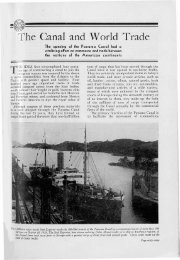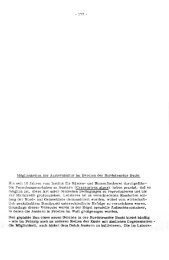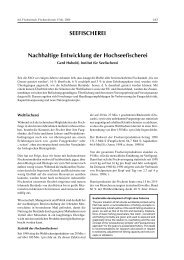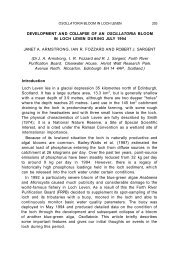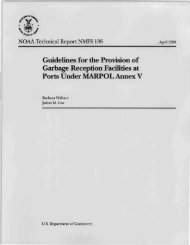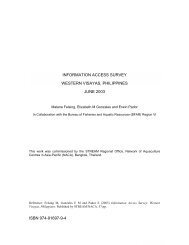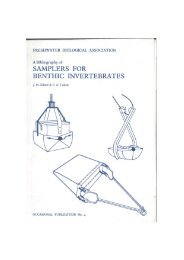The Economic Importance Of Marine Angler Expenditures In
The Economic Importance Of Marine Angler Expenditures In
The Economic Importance Of Marine Angler Expenditures In
Create successful ePaper yourself
Turn your PDF publications into a flip-book with our unique Google optimized e-Paper software.
this paper reflect only those impacts that remain within<br />
a given state. Storey and Allen (1993) accounted for the<br />
effects of imports on local supply in Massachusetts, however,<br />
the methods and assumptions used in constructing<br />
several components of the input-output model (e.g.,<br />
production functions and margins) varied considerably<br />
from those employed with the IMPLAN system. <strong>In</strong> addition,<br />
Storey and Allen (1993) used the standard type<br />
II multiplier to estimate the induced effects of angler<br />
expenditures. This procedure assumes that all household<br />
income is spent within the state of Massachusetts<br />
and that income and consumption are linearly related;<br />
that is, when income increases/decreases consumption<br />
increases/decreases proportionately. If household<br />
income is being spent outside the state or the marginal<br />
propensity to consume is not constant, then the type II<br />
multiplier will be overstated. <strong>The</strong> estimates shown in this<br />
study were based on IMPLAN’s type SAM multipliers<br />
which use information about inter-institutional transfers<br />
from IMPLAN’s social accounting matrix to account<br />
for leakage of household income out of the region,<br />
and a nonlinear consumption function that allows the<br />
marginal propensity to consume to decrease as income<br />
rises (see Minnesota IMPLAN Group, <strong>In</strong>c., 1997). <strong>The</strong><br />
differences between Kirkley and Kerstetter’s (1997) expenditure<br />
and impact estimates for Virginia and those<br />
shown in this report are not as easily explained. Different<br />
sampling procedures and expenditure categories<br />
may have contributed to the overall disparities between<br />
angler expense estimates, although the estimates are<br />
generally comparable for expense categories identified<br />
in both studies. Kirkley and Kerstetter’s (1997) impact<br />
estimates, however, are considerably higher than those<br />
generated in this study. <strong>The</strong> majority of the difference<br />
can be traced to discrepancies between the induced<br />
impact estimates. Kirkley and Kerstetter (1997) used the<br />
traditional type II multiplier to calculate impacts. Typically,<br />
the type II multiplier will result in higher induced<br />
values than IMPLAN’s type SAM multiplier. While these<br />
differences may explain some of the variation in the<br />
estimates, a systematic evaluation of both studies would<br />
be necessary to reveal all of the discrepancies between<br />
the two studies.<br />
<strong>In</strong> the SE, Bell, Sorensen, and Leeworthy (1982)<br />
estimated that saltwater recreational anglers spent $1.9<br />
billion in Florida in 1982, which equates to approximately<br />
$3.2 billion in 1999 dollars (according to the<br />
consumer price index). This is $5.1 billion lower than<br />
the estimate presented in Gentner, Price, and Steinback<br />
(2001a) for Florida in 1999 ($8.3 billion). <strong>In</strong> contrast,<br />
Bell, Sorensen, and Leeworthy (1982) predicted the<br />
total sales impact of anglers’ expenditures to be $8.8<br />
billion in 1999 dollars, approximately $4.2 billion<br />
higher than our estimate of sales derived from angler<br />
expenditures in Florida ($4.6 billion). <strong>The</strong>ir analysis<br />
did not include expenditures on durable goods, and<br />
the estimates of impacts were derived from various<br />
relationships between fishing expenditures and total<br />
expenditures in Florida. This rather atypical modeling<br />
approach is significantly different from the input-output<br />
approach presented here, so substantial differences in<br />
expenditure and impact estimates would be expected.<br />
<strong>The</strong> authors could find no other state or regional level<br />
analyses of saltwater recreational angling expenditures<br />
or impacts in the SE.<br />
For the PAC, McWilliams and Goldman (1994) estimated<br />
the economic impacts of both fresh and saltwater fishing<br />
in California in 1992. <strong>The</strong> authors used the IMPLAN<br />
Pro system and 1998 expenditure estimates provided by<br />
the ASA to generate impact estimates. <strong>Angler</strong>s’ expenditures<br />
on fresh and saltwater fishing combined were<br />
estimated to generate almost $5 billion dollars in sales/<br />
output impacts in California. Unfortunately, because<br />
freshwater and saltwater expenditures were aggregated<br />
in this study, it is not possible to compare estimates.<br />
Conclusion<br />
<strong>The</strong> impact estimates shown in this report may underestimate<br />
the state-level effects associated with marine<br />
recreational fishing. Because separate models were<br />
constructed for each state, the impacts measured only<br />
those effects that occurred within the state of interest.<br />
Impacts generated through the imports of goods and<br />
services from other neighboring coastal states were not<br />
part of each individual state assessment. For example,<br />
if a retail store in Rhode Island sold fishing tackle that<br />
was manufactured in Massachusetts, the impacts associated<br />
with the production of the fishing tackle were not<br />
part of the Rhode Island nor the Massachusetts impact<br />
assessment. <strong>The</strong> associated wholesale, distribution, and<br />
retail mark-ups that occurred in Rhode Island were<br />
included in the Rhode Island impact assessment, but<br />
the portion attributable to tackle manufacturing was<br />
not included in the Massachusetts assessment since the<br />
effects were generated from angler purchases in Rhode<br />
Island. As such, the impacts could have been higher<br />
than those shown in this report for states that exported<br />
fishing-related commodities to other neighboring<br />
coastal states. 15 <strong>The</strong>se impacts, however, are captured<br />
in the aggregate U.S. model.<br />
15 <strong>The</strong> interstate effects could have been determined by constructing<br />
an aggregate regional input-output model that included all<br />
coastal states within a region. This model would have been capable<br />
of tracking all of the associated trade and distribution channels<br />
that existed among the coastal states in the region. <strong>The</strong> IMPLAN<br />
system allows users to create aggregate models of this kind, but at<br />
the present time the software does not provide the ability to adequately<br />
isolate the impacts of the sub regions (i.e., coastal states)<br />
in aggregate models.<br />
9



